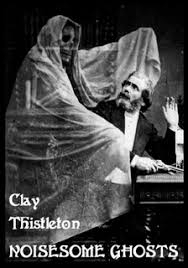
Reviewed by Gregory M. Westlake
This is a handsomely presented book, with the cover appropriately showing Thiebault’s ‘Henri Robin and a Spectre’; the famous photograph of a man about to shoot himself, being confronted by his own ghost (1863). The text of this book, of various verselets, runs for a very substantial 455 pages, with a respectable reference list of 13 pages. Clay Thistleton, is an academic from New South Wales, Australia, teaching creative writing and literary studies at universities and community colleges for almost two decades. This book then, is a vast collection of poems written, and spoken by ghosts, poltergeists and phantoms; dating from the second millennium BCE to the present day. So, this, a highly worthwhile volume, documents the entire known history of these mysterious literate entities. Accordingly, the tome makes for an intense experience for the reader, perhaps succeeding in converting the sceptic, to such non-mainstream thought. I believe the compilation would have benefited from an introduction to contextualize this most alternative modality of literature. The reader would be challenged to peruse this publication for a prolonged spell of time, as Thistleton relentlessly delivers punch line after punch line. The author does include a useful ‘How to Use this Book’ page, (p.viii); however, the format is most potent. In fact, this really should serve as a reference work to be consulted on occasion, especially as there are some original rarities included. The study of these versifications, at times comical, can also be, an extremely morbid, distressing experience; so be warned, inter-psychic balance, wisdom, and an element of sophistication, are required for the reader to get the most out of this title.
As a specialist academic, in the realms of the altered state of consciousness, of schizophrenia, and mysticism; I can see the relationship of the other-world of spiritualism, and the after-life, to insanity. Consequently, this is one of the merits of this work to the psychologist, as it is well known that the back-wards of provincial asylums, can, at times be, receptacles of the occult. For instance, we can read of ‘The Sendai Possessions’ (2011), taken from the London Review of Books (Parry, 2014 quoted on p. 290):
Am I alive?
Or not?
I’m at the bottom of the sea
It is very cold
& there are bodies
All around me
[Choking sounds]
Fascinating, as this was taken from the time of the Japanese apocalypse, after the tsunami, on the 11th of March 2011. The previous day had been spent in deep conversation discussing premonitions, insanity and parapsychology, in a casual séance situation with a highly respected parapsychologist. Such inclusion of evidence, is potentially opinion forming, and certainly broadens one’s vision with respect to the after-life and occult phenomena.
This thinking clearly has a relevant application in contemporary consciousness, given the tremendous surge in violent deaths, and entropy throughout the U.K. ’Cynicism increases social distance and diminishes the public spirit’ (Gore, 1994 in Berman, 1997). When citizens believe, ‘that government is plotting to exploit and brainwash citizens, they become ardently cynical and withdraw from government’ (Berman, 1997). Paranormal phenomena has become taboo, and, ‘one of the most powerful bans of modern times’ (Mousseau, 2003). In fact, it is said, ‘pseudo-science neglects empirical matters, yet 43% of articles in the fringe journals deal with empirical matters’ (Mousseau, 2003).
The Sunday Telegraph has equivocally printed that ‘All right-thinking persons must protest against any suggestion of exorcism. A ghost is a priceless cultural, academic and environmental asset’ (Muckle, 1998 quoted on p.190). ‘The concept of consciousness does not appear in any presently known physical laws…it does not appear to occupy physical space…so psi phenomena may be giving us an advance view of some of these principles’ (Alcock, Burns & Freeman, 2003). The mis-information of the public, generally speaking, might transgress into pathological skepticism, or, ‘pseudoskepticism’, without the necessary scholarly documents and writings in place for a more balanced attitude.
Although poltergeist cases cannot justifiably be claimed to provide strong evidential support for the survival hypothesis the fact remains, we are not yet in a position to discount any of the major theoretical approaches to the poltergeist experience (Irwin & Watt, 2007).
So, the author provides a consistently healthy counter argument in the form of quotations, ‘It was just like living in a horror movie’ (p.346); and, ‘I get some desperate phone calls. What people want initially is knowledge. Like what is in our house, why is it there, what does it want and will we be murdered in our beds’ (p.23). To conclude, it is comprehendible why certain individuals might, ‘actually have a phobia about reading material that is contrary to their own views’, (Leiter, 2002),’it seems entirely possible that they fear contamination’. This brave collection is for those who would rather live in the mystery of eternity.
References
Alcock, J., Burns, J., & Freeman, A. (2003). Psi Wars: Getting to Grips with the Paranormal. Exeter.
Imprint Academic.
Berman, E. M. (1997). Dealing with Cynical Citizens. Public Administration Review, 57, 105-112.
Irwin, H. J., & Watt, C. A. (2007). An Introduction to Parapsychology (5th Ed.). Jefferson,
NC: McFarland.
Leiter, L. D. (2002). The Pathology of Organized Skepticism. Journal of Scientific Exploration, 16,
125-128.
Mousseau, M.-C. (2003). Parapsychology: Science or Pseudo-Science? Journal of Scientific
Exploration, 17, 271-282.

